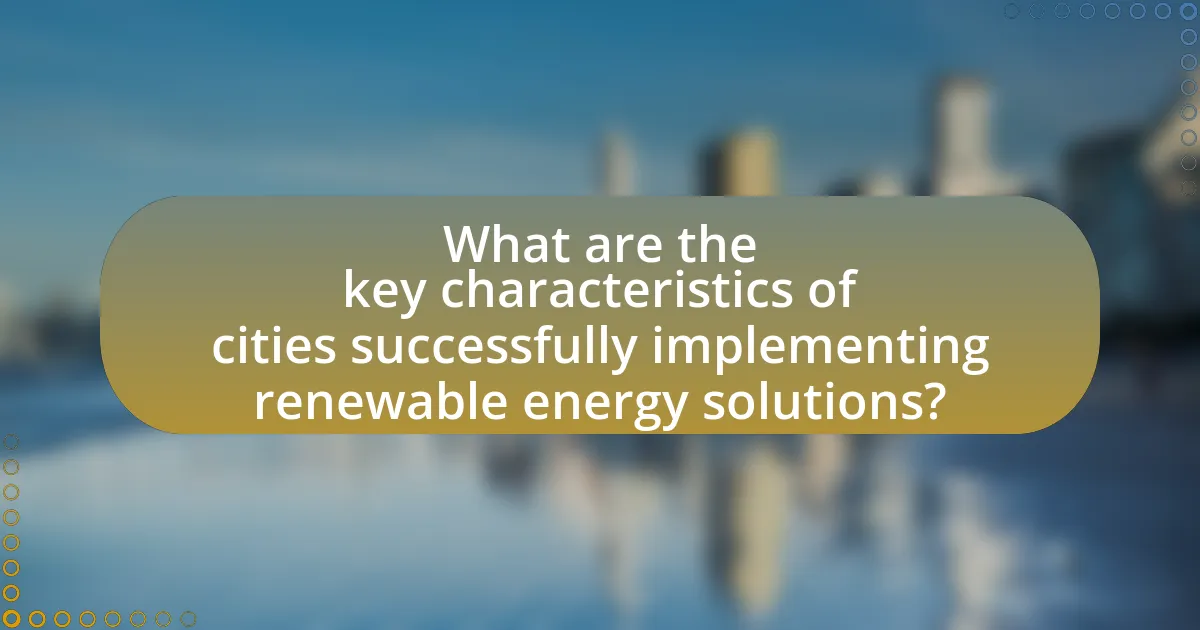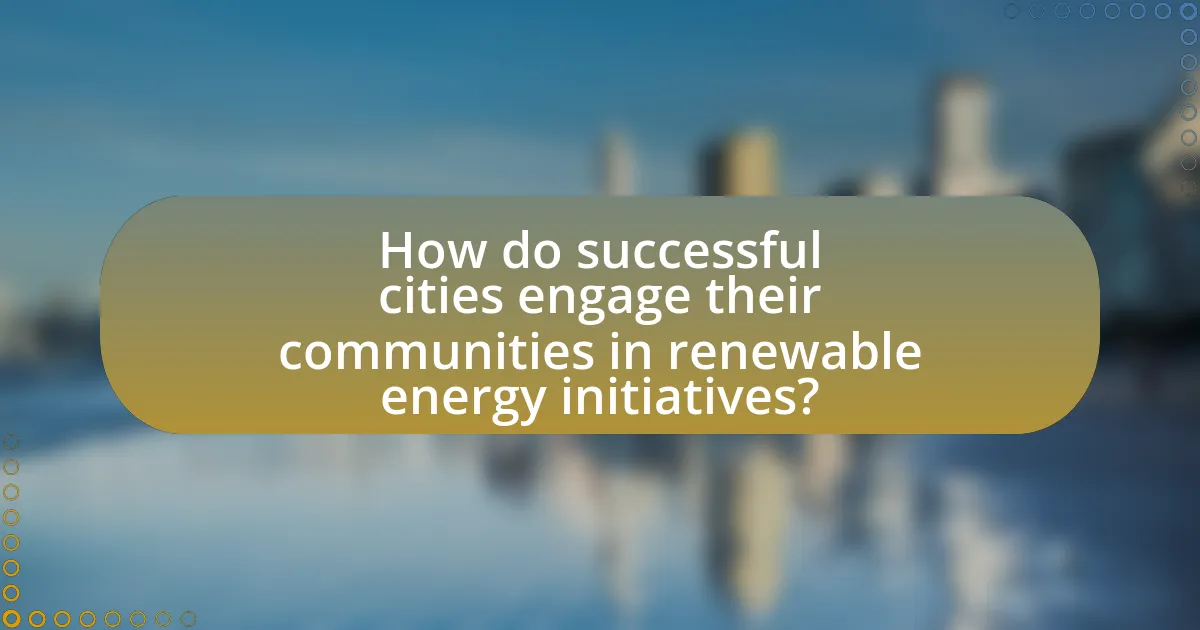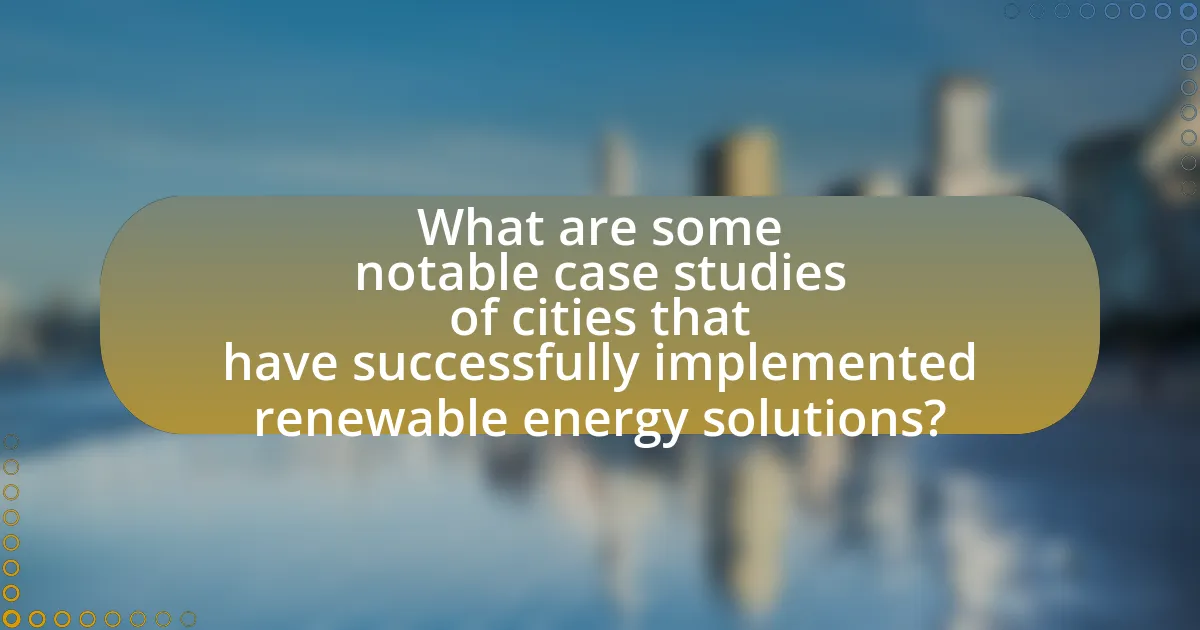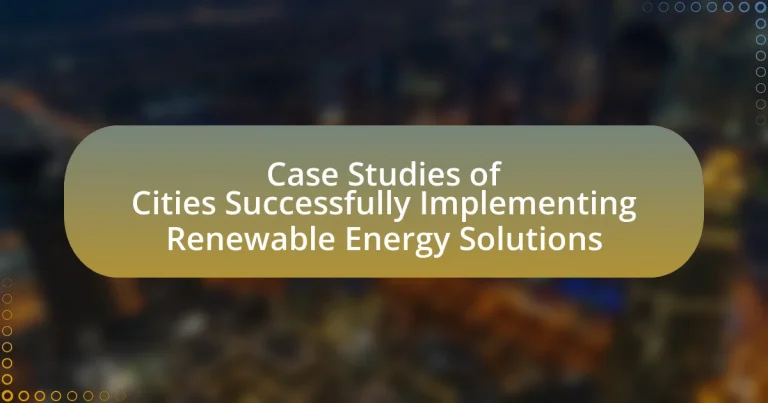The article focuses on case studies of cities that have successfully implemented renewable energy solutions, highlighting key characteristics such as strong political commitment, comprehensive planning, and community engagement. It examines how these cities define their renewable energy goals, set specific targets for adoption, and measure progress through various metrics. The article also discusses the types of renewable energy solutions being utilized, including solar, wind, and hydroelectric power, and the challenges cities face in transitioning to sustainable energy. Additionally, it explores community involvement strategies, financial barriers, and regulatory frameworks that impact renewable energy projects, using examples from cities like San Diego and Copenhagen to illustrate effective practices and lessons learned.

What are the key characteristics of cities successfully implementing renewable energy solutions?
Cities successfully implementing renewable energy solutions typically exhibit strong political commitment, comprehensive planning, and community engagement. Political commitment is evidenced by local governments setting ambitious renewable energy targets and creating supportive policies, such as incentives for solar and wind energy adoption. Comprehensive planning involves integrating renewable energy into urban development strategies, ensuring infrastructure supports sustainable energy sources. Community engagement is crucial, as successful cities actively involve residents in decision-making processes, fostering public support and participation in renewable initiatives. For instance, San Diego has committed to 100% renewable energy by 2035, backed by a detailed climate action plan and extensive community outreach efforts.
How do these cities define their renewable energy goals?
Cities define their renewable energy goals by establishing specific targets for the percentage of energy derived from renewable sources, often accompanied by timelines for achieving these targets. For instance, many cities aim for 100% renewable energy by a certain year, such as 2030 or 2050, and outline strategies that include increasing solar and wind energy capacity, enhancing energy efficiency, and promoting electric vehicles. These goals are typically formalized in sustainability plans or climate action plans, which are supported by data on current energy consumption and projections for future energy needs. For example, San Diego has set a goal to reach 100% renewable energy by 2035, backed by a comprehensive plan that includes investments in solar energy and energy storage solutions.
What specific targets do they set for renewable energy adoption?
Cities implementing renewable energy solutions typically set specific targets such as achieving 100% renewable energy by a certain year, increasing the share of renewable energy in their energy mix to a defined percentage, or reducing greenhouse gas emissions by a specific amount. For example, San Diego aims for 100% renewable energy by 2035, while Seattle targets a 100% clean energy supply by 2030. These targets are often backed by local legislation and climate action plans that outline measurable milestones and strategies to ensure accountability and progress towards these goals.
How do they measure progress towards these goals?
Cities measure progress towards renewable energy goals through specific metrics such as the percentage of energy generated from renewable sources, reductions in greenhouse gas emissions, and improvements in energy efficiency. For example, a city may track the increase in solar panel installations or the amount of wind energy produced annually. Additionally, cities often utilize benchmarking tools and performance indicators to assess their advancements, such as the Global Covenant of Mayors for Climate and Energy, which provides a framework for cities to report their progress. These methods ensure that cities can quantitatively evaluate their efforts and make data-driven decisions to enhance their renewable energy strategies.
What types of renewable energy solutions are being implemented?
Cities are implementing various types of renewable energy solutions, including solar power, wind energy, geothermal energy, and biomass energy. For instance, solar power installations have surged globally, with cities like San Diego and Barcelona leading in solar panel deployment, significantly reducing their carbon footprints. Wind energy is also being harnessed, as seen in cities like Chicago, which has invested in wind farms to generate clean electricity. Geothermal energy is utilized in places like Reykjavik, where it provides heating and electricity, showcasing its efficiency. Additionally, biomass energy is being adopted in cities such as Stockholm, where waste is converted into energy, contributing to sustainable waste management and energy production. These implementations demonstrate a commitment to reducing reliance on fossil fuels and promoting sustainable energy practices.
What role do solar, wind, and hydroelectric power play in these cities?
Solar, wind, and hydroelectric power serve as critical components of the renewable energy landscape in cities, significantly contributing to their energy needs and sustainability goals. In many urban areas, solar power provides a decentralized energy source, allowing buildings to generate electricity on-site, which reduces reliance on fossil fuels and lowers greenhouse gas emissions. For instance, cities like San Diego have implemented extensive solar programs, resulting in over 1,000 megawatts of solar capacity, which powers thousands of homes.
Wind energy plays a vital role in cities with access to suitable locations for wind farms, contributing to large-scale electricity generation. For example, Chicago has harnessed wind power effectively, with wind farms in nearby areas supplying a substantial portion of the city’s energy, thereby enhancing energy security and reducing carbon footprints.
Hydroelectric power, particularly in cities near water bodies, provides a stable and reliable energy source. Cities like Seattle benefit from hydroelectric plants that generate a significant percentage of their electricity, often exceeding 90%, which supports local industries and residential needs while promoting environmental sustainability.
Together, these renewable energy sources not only help cities meet their energy demands but also align with broader climate action initiatives, demonstrating a commitment to reducing environmental impact and fostering sustainable urban development.
How do cities integrate multiple renewable energy sources?
Cities integrate multiple renewable energy sources by developing comprehensive energy strategies that combine solar, wind, hydro, and biomass systems. For instance, San Diego utilizes a mix of solar panels and wind turbines to meet its energy needs, aiming for 100% renewable energy by 2035. This integration is facilitated through smart grid technology, which optimizes energy distribution and storage, ensuring reliability and efficiency. Additionally, cities often implement policies that encourage the use of diverse energy sources, such as incentives for solar installations and partnerships with local utilities to enhance grid resilience.
What challenges do these cities face in implementing renewable energy solutions?
Cities face several challenges in implementing renewable energy solutions, including financial constraints, regulatory hurdles, and technological limitations. Financially, many cities struggle to secure the necessary funding for large-scale renewable projects, often relying on limited budgets and competing priorities. Regulatory hurdles arise from complex permitting processes and outdated policies that can delay project approvals. Additionally, technological limitations, such as insufficient infrastructure for energy storage and distribution, hinder the effective integration of renewable sources into existing energy systems. These challenges collectively impede the transition to sustainable energy solutions in urban environments.
How do regulatory and policy frameworks impact renewable energy projects?
Regulatory and policy frameworks significantly influence renewable energy projects by establishing the legal and financial conditions necessary for their development. These frameworks can provide incentives such as tax credits, grants, and feed-in tariffs, which encourage investment in renewable technologies. For instance, the U.S. Investment Tax Credit (ITC) has been pivotal in boosting solar energy installations, resulting in a 167% increase in solar capacity from 2010 to 2020. Additionally, regulations can streamline permitting processes, reducing the time and cost associated with project development. Conversely, stringent regulations or lack of supportive policies can hinder project viability, as seen in regions with limited renewable energy mandates. Thus, effective regulatory and policy frameworks are essential for fostering a conducive environment for renewable energy projects.
What financial barriers do cities encounter when transitioning to renewable energy?
Cities encounter significant financial barriers when transitioning to renewable energy, primarily due to high upfront capital costs and limited access to financing. The initial investment required for renewable energy infrastructure, such as solar panels and wind turbines, can be substantial, often exceeding millions of dollars. For instance, a study by the International Renewable Energy Agency (IRENA) indicates that the average cost of solar photovoltaic systems can range from $1,000 to $3,000 per installed kilowatt, which poses a challenge for municipal budgets. Additionally, cities may struggle to secure funding from private investors or financial institutions due to perceived risks associated with renewable projects, leading to a reliance on government grants or subsidies that may not be consistently available. This financial uncertainty can hinder long-term planning and investment in sustainable energy solutions.

How do successful cities engage their communities in renewable energy initiatives?
Successful cities engage their communities in renewable energy initiatives through inclusive planning processes and educational outreach programs. For instance, cities like San Diego and Copenhagen actively involve residents in decision-making by hosting workshops and public forums, allowing community members to voice their opinions and contribute to local energy strategies. Additionally, these cities implement educational campaigns that inform citizens about the benefits of renewable energy, leading to increased public support and participation. Research indicates that community engagement in energy initiatives can enhance project acceptance and foster a sense of ownership, as seen in the case of the Solarize program in Portland, which resulted in a significant increase in residential solar installations.
What strategies do cities use to raise public awareness about renewable energy?
Cities employ various strategies to raise public awareness about renewable energy, including educational campaigns, community engagement initiatives, and partnerships with local organizations. Educational campaigns often involve workshops, seminars, and informational materials that explain the benefits and importance of renewable energy. For instance, San Diego’s “Renewable Energy Program” provides resources and training to residents about solar energy options. Community engagement initiatives, such as public forums and events, encourage dialogue and participation, exemplified by Seattle’s “Green Up” program, which invites residents to share their experiences and ideas. Additionally, partnerships with local organizations, like the collaboration between New York City and the Urban Future Lab, help amplify outreach efforts and provide expert insights, thereby enhancing public understanding and support for renewable energy initiatives.
How do educational programs contribute to community engagement?
Educational programs enhance community engagement by fostering awareness and understanding of renewable energy solutions. These programs provide residents with knowledge about sustainable practices, encouraging participation in local initiatives. For instance, cities that implement educational workshops on solar energy have seen increased community involvement in solar panel installations, leading to a 20% rise in adoption rates, as reported by the National Renewable Energy Laboratory. This engagement not only empowers individuals but also strengthens community ties, as residents collaborate on projects that benefit the environment and local economy.
What role do local organizations play in promoting renewable energy?
Local organizations play a crucial role in promoting renewable energy by facilitating community engagement, providing education, and advocating for policy changes. These organizations often serve as intermediaries between government entities, businesses, and residents, helping to raise awareness about the benefits of renewable energy sources such as solar and wind. For instance, local non-profits and community groups frequently organize workshops and informational sessions that inform citizens about renewable energy options and incentives available to them. Additionally, they may collaborate with local governments to develop and implement renewable energy initiatives, as seen in cities like San Diego, where organizations have successfully influenced local energy policies to support solar energy adoption. This active involvement not only fosters a culture of sustainability but also drives local economic growth through job creation in the renewable energy sector.
How do cities encourage citizen participation in renewable energy projects?
Cities encourage citizen participation in renewable energy projects through initiatives such as community engagement programs, educational workshops, and financial incentives. For instance, cities like San Diego have implemented community solar programs that allow residents to invest in local solar projects, thereby fostering a sense of ownership and involvement. Additionally, educational workshops in cities like Amsterdam inform citizens about renewable energy benefits and technologies, enhancing public understanding and support. Financial incentives, such as tax credits or rebates for solar panel installations, further motivate citizens to participate actively in these projects, as seen in cities like Portland, which reported a significant increase in solar installations due to such incentives.
What incentives are offered to residents for adopting renewable energy solutions?
Residents are offered various incentives for adopting renewable energy solutions, including tax credits, rebates, and grants. For example, the federal government in the United States provides a solar investment tax credit (ITC) that allows homeowners to deduct a significant percentage of the cost of solar systems from their federal taxes. Additionally, many states and local governments offer rebates for solar panel installations, which can significantly reduce upfront costs. According to the Database of State Incentives for Renewables & Efficiency (DSIRE), over 1,000 incentive programs exist across the U.S., demonstrating a strong commitment to promoting renewable energy adoption among residents.
How do cities facilitate community-led renewable energy initiatives?
Cities facilitate community-led renewable energy initiatives by providing supportive policies, funding opportunities, and infrastructure development. For instance, many cities implement zoning laws that allow for the installation of solar panels on residential and commercial properties, thereby encouraging local participation in renewable energy projects. Additionally, cities often establish grant programs or financial incentives to lower the initial costs for community members interested in renewable energy installations. A notable example is San Diego, which has set ambitious renewable energy goals and offers resources for community groups to develop solar energy projects, resulting in increased local engagement and investment in sustainable practices.

What are some notable case studies of cities that have successfully implemented renewable energy solutions?
Copenhagen, Denmark, is a notable case study for successfully implementing renewable energy solutions, aiming to become carbon neutral by 2025. The city has invested heavily in wind energy, with over 60% of its electricity generated from wind turbines. Additionally, Copenhagen has integrated district heating systems that utilize waste heat and biomass, significantly reducing fossil fuel dependency. Another example is San Diego, California, which has committed to 100% renewable energy by 2035, primarily through solar power and energy efficiency programs. The city has installed thousands of solar panels and implemented community choice aggregation, allowing residents to choose renewable energy sources. These cities exemplify effective strategies in transitioning to renewable energy, supported by specific policies and investments in infrastructure.
What lessons can be learned from San Diego’s renewable energy strategy?
San Diego’s renewable energy strategy teaches the importance of comprehensive planning and community engagement in achieving sustainability goals. The city has set a target to reach 100% renewable energy by 2035, demonstrating the effectiveness of clear, ambitious objectives. Additionally, San Diego’s approach emphasizes the integration of diverse energy sources, including solar, wind, and energy storage, which enhances resilience and reliability in the energy supply. The city also showcases the value of public-private partnerships, as collaborations with local businesses and organizations have facilitated investment and innovation in renewable technologies. These lessons highlight that successful renewable energy strategies require a multifaceted approach that includes strong policy frameworks, community involvement, and diverse energy portfolios.
How did San Diego achieve its ambitious renewable energy targets?
San Diego achieved its ambitious renewable energy targets by implementing a comprehensive strategy that includes a commitment to 100% renewable energy by 2035, extensive investment in solar energy, and the establishment of community choice aggregation programs. The city has installed over 1,000 megawatts of solar capacity, making it one of the leading cities in solar energy generation in the United States. Additionally, San Diego’s Climate Action Plan outlines specific measures to reduce greenhouse gas emissions and increase energy efficiency, further supporting its renewable energy goals.
What innovative technologies were utilized in San Diego’s approach?
San Diego utilized innovative technologies such as advanced solar energy systems, energy storage solutions, and smart grid technology in its approach to renewable energy. The city implemented a significant number of solar panels, which contributed to its goal of achieving 100% renewable energy by 2035. Additionally, San Diego invested in energy storage systems to manage the intermittent nature of solar power, ensuring a reliable energy supply. The integration of smart grid technology allowed for improved energy management and efficiency, facilitating real-time monitoring and control of energy resources. These technologies collectively support San Diego’s commitment to sustainable energy solutions.
How has Copenhagen become a leader in renewable energy implementation?
Copenhagen has become a leader in renewable energy implementation by committing to ambitious climate goals and investing heavily in wind energy and district heating systems. The city aims to become carbon neutral by 2025, which has driven significant policy initiatives and infrastructure development. As of 2021, approximately 47% of Copenhagen’s energy consumption comes from renewable sources, primarily wind power, supported by over 400 wind turbines in and around the city. Additionally, the integration of a district heating system, which utilizes waste heat and biomass, has further reduced reliance on fossil fuels. These strategic investments and policies have positioned Copenhagen as a global model for sustainable energy practices.
What specific policies contributed to Copenhagen’s success?
Copenhagen’s success in renewable energy implementation is primarily attributed to its ambitious climate action plan, which includes a commitment to becoming carbon neutral by 2025. This plan is supported by specific policies such as the promotion of wind energy, extensive investment in cycling infrastructure, and the integration of district heating systems. For instance, Copenhagen has invested heavily in offshore wind farms, which now supply a significant portion of the city’s energy needs, contributing to a 40% reduction in carbon emissions since 1990. Additionally, the city has developed a comprehensive cycling strategy that encourages bike use, resulting in over 62% of residents commuting by bicycle daily. These policies collectively demonstrate Copenhagen’s effective approach to sustainable urban energy solutions.
How does Copenhagen’s approach differ from other cities?
Copenhagen’s approach to renewable energy differs from other cities primarily through its ambitious goal of becoming carbon neutral by 2025. This commitment is supported by a comprehensive strategy that includes significant investments in wind energy, with over 40% of the city’s energy coming from wind turbines, and extensive cycling infrastructure that promotes sustainable transportation. Additionally, Copenhagen’s integration of district heating systems, which utilize waste heat and biomass, sets it apart from many cities that rely more heavily on fossil fuels. These initiatives demonstrate a holistic and innovative approach to sustainability, making Copenhagen a leader in urban renewable energy solutions.
What best practices can other cities adopt from these case studies?
Cities can adopt several best practices from case studies of successful renewable energy implementations, including comprehensive policy frameworks, community engagement, and investment in technology. Comprehensive policy frameworks, such as those seen in cities like San Diego, establish clear goals and regulations that guide renewable energy adoption, resulting in a 50% reduction in greenhouse gas emissions by 2035. Community engagement, exemplified by initiatives in Copenhagen, fosters public support and participation, leading to increased acceptance and investment in renewable projects. Additionally, investment in technology, as demonstrated by Amsterdam’s focus on smart grids, enhances energy efficiency and integration of renewable sources, contributing to a 30% increase in renewable energy usage. These practices collectively create a robust foundation for cities aiming to transition to renewable energy.
What common strategies are effective across different cities?
Common strategies effective across different cities in implementing renewable energy solutions include establishing clear policy frameworks, investing in public awareness campaigns, and fostering public-private partnerships. Cities like San Diego, California, and Copenhagen, Denmark, have demonstrated that comprehensive policy frameworks, such as renewable energy targets and incentives, drive adoption. Public awareness campaigns in cities like Melbourne, Australia, have successfully educated residents on energy efficiency and renewable options, leading to increased participation. Additionally, public-private partnerships, as seen in Amsterdam, Netherlands, facilitate innovation and investment in renewable technologies, enhancing overall effectiveness. These strategies collectively contribute to the successful implementation of renewable energy solutions across diverse urban environments.
How can cities tailor these strategies to their unique contexts?
Cities can tailor renewable energy strategies to their unique contexts by conducting comprehensive assessments of local resources, demographics, and energy needs. For instance, cities with abundant sunlight, like Phoenix, Arizona, can prioritize solar energy installations, while coastal cities such as San Diego may focus on wind and tidal energy due to their geographical advantages. Additionally, engaging local stakeholders, including residents and businesses, ensures that the strategies align with community values and economic conditions. This approach is supported by the International Renewable Energy Agency, which emphasizes the importance of localized planning in achieving effective energy transitions.


